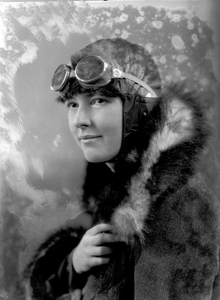
The de Havilland DH.60 Moth is a 1920s British two-seat touring and training aircraft that was developed into a series of aircraft by the de Havilland Aircraft Company.

Hucknall Aerodrome was a former general aviation and RAF aerodrome located 5 nmi north north-west of Nottingham, Nottinghamshire, England and west of Hucknall town. The aerodrome had been operated by the Merlin Flying Club since 1971 and then by Rolls-Royce Group plc. Before its closure, it was owned and operated by ITP Aero.

Netherthorpe Aerodrome is located 2 NM west by north of Worksop, Nottinghamshire, England. The aerodrome is in the Metropolitan Borough of Rotherham close to the village of Thorpe Salvin.

Heston Aerodrome was an airfield located to the west of London, England, operational between 1929 and 1947. It was situated on the border of the Heston and Cranford areas of Hounslow, Middlesex. In September 1938, the British Prime Minister, Neville Chamberlain, flew from Heston to Germany three times in two weeks for talks with Adolf Hitler, and returned to Heston from the Munich Conference with the paper referred to in his later "Peace for our time" speech from 10 Downing Street.
The Lancashire Aero Club is the oldest established flying club in the United Kingdom, it was founded in 1909 to organise the Blackpool Aviation Week, Britain's first officially recognised air show.
Lympne Airport was a military and later civil airfield, at Lympne, Kent, United Kingdom, which operated from 1916 to 1984. During the First World War RFC Lympne was originally an acceptance point for aircraft being delivered to, and returning from, France but was later designated as a First Class Landing Ground, RAF Lympne. It became a civil airfield in 1919 and saw the operation of early air mail services after the 1918 armistice. It was one of the first four airfields in the United Kingdom with customs facilities.

Penshurst Airfield was an airfield in operation between 1916–36 and 1940–46. Initially a military airfield, after the First World War it was used as an alternate destination to Croydon Airport, with some civil flying taking place. The airfield closed following the crash of a Flying Flea at an air display in 1936, and was converted to a polo ground.
Ramsgate Airport was a civil airfield at Ramsgate, Kent, United Kingdom which opened in July 1935. It was briefly taken over by the Royal Air Force in the Second World War, becoming RAF Ramsgate. The airfield was then closed and obstructed to prevent its use. It reopened in 1953 and served until final closure in 1968. The site has now been redeveloped as an industrial estate.
Allied Airways was a UK airline based at Aberdeen, Scotland. Formed in 1934 as Aberdeen Airways it was taken over by British European Airways in 1947.
Constance Ruth Leathart was a British female pilot who flew Royal Air Force aircraft on transit flights in World War Two in the Air Transport Auxiliary.

Bekesbourne Aerodrome was an airport located at the southeast edge of the village of Bekesbourne, southeast of Canterbury, Kent. It operated from 1916 until 1940, and had both military and civil roles.
Western Airways was an airline based in Weston-super-Mare, Somerset, England between 1932 and 1978. Before World War II, for a short period, it was the world's busiest airline. It survived WWII by using its aircraft engineering expertise.
Haldon Aerodrome was the first airfield in Devon. Established in the 1920s as a private flying field, it developed into an airport with scheduled airline service, and was used by the Navy during World War II. The airport has also been known as Teignmouth Airport, Little Haldon Airfield and, in its military days, RNAS Haldon and HMS Heron II.
Highland Airways Limited was established in Inverness, Scotland, by Ted Fresson in 1933 to provide passenger and freight air services between the Scottish mainland and the Northern Isles of Orkney and Shetland, and between their islands. The airline was taken over by Scottish Airways, absorbed by British European Airways in 1947.
Northern & Scottish Airways was a regional airline established in Glasgow in 1934. It was taken over in 1937, eventually becoming part of British European Airways.
Midland & Scottish Air Ferries was Scotland's first airline, operating from 1933 to 1934. It is particularly noted for pioneering flights to the Inner Hebrides

Lancashire Aircraft Corporation was a major British charter airline after World War II. Its founding father was Eric Rylands. It played an important role in the Berlin Airlift. It also flew scheduled routes and was important in the development of Coach-air services, leading to the founding of Skyways Coach Air and the start of the Inclusive Tour (IT) industry. Its major subsidiary, Samlesbury Engineering, supported its operations and converted many military aircraft for commercial use, also founding Lancashire Aircraft Company.
North Eastern Airways (NEA) was a British airline which operated from 1935 until the outbreak of World War II in 1939. Based initially in Newcastle upon Tyne, it operated routes from Scotland to London in competition with the railways, retaining its independence to the end.

National Flying Services Ltd was a company aiming to create and manage a large number of airfields and flying clubs around Britain. It relied on government subsidy, and it collapsed when the subsidy was withdrawn in 1934, because the aims had not been achieved.

Winifred Sawley Brown was an English sportswoman, aviator and author. She was the first woman to win the King's Cup air race. The race has been running annually since 1922.















